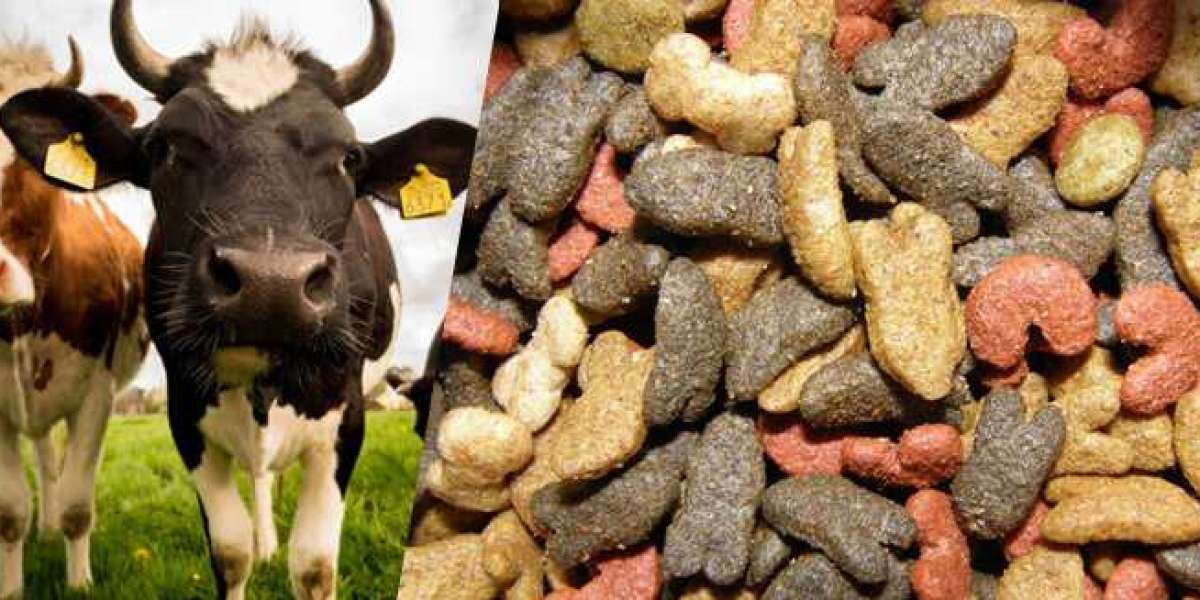The animal feed additives market has seen significant growth in recent years, fueled by an increasing demand for meat, dairy, and eggs, as well as rising awareness of animal health and productivity. Animal feed additives are essential ingredients in animal diets that help to improve nutritional content, digestion, and overall performance. As the agricultural industry faces new challenges, including a growing global population, concerns about antibiotic use, and a focus on sustainability, the role of animal feed additives has never been more important.
Understanding Animal Feed Additives
Animal feed additives are substances added to livestock feed to improve its quality and effectiveness. These additives come in various forms, each serving different functions, including enhancing nutritional content, promoting animal growth, improving feed efficiency, and boosting immunity. Common types of feed additives include:
- Nutritional Additives: These include vitamins, minerals, amino acids, and other essential nutrients that ensure animals receive a balanced diet, supporting growth, development, and overall health.
- Zootechnical Additives: These are designed to improve the performance of animals in terms of growth rate, feed conversion efficiency, and reproductive health. Growth promoters, antioxidants, and antibiotics are examples of zootechnical additives.
- Functional Additives: These additives, such as probiotics, prebiotics, and enzymes, support digestive health, enhance nutrient absorption, and improve overall feed efficiency.
Factors Driving Market Growth
- Rising Meat and Dairy Consumption The global demand for animal-based products, particularly meat, dairy, and eggs, continues to rise as the world’s population grows and urbanizes. This has driven the need for more efficient animal farming practices, which can be achieved with the help of feed additives. By improving feed conversion ratios and accelerating animal growth rates, feed additives are helping producers meet the growing demand for animal protein.
- Focus on Animal Health and Welfare The increasing focus on animal health and welfare is one of the primary drivers for the growth of the animal feed additives market. Feed additives such as probiotics, prebiotics, and enzymes help to improve digestion, boost immunity, and reduce disease incidence, ensuring that animals remain healthy throughout their production cycles.
- Sustainability in Livestock Farming Sustainability has become a key concern for the agricultural industry. Feed additives are helping livestock producers improve feed efficiency, reduce waste, and minimize environmental impact. Additives that enhance feed digestion, reduce methane emissions, and promote more efficient nutrient absorption contribute to a more sustainable and eco-friendly livestock farming system.
- Regulatory Pressures Governments and regulatory bodies around the world are implementing stricter standards for animal feed quality, safety, and animal welfare. These regulations are pushing the adoption of higher-quality feed additives that improve animal health, safety, and productivity. As a result, feed manufacturers are investing in innovative additives to comply with these standards and meet consumer demands for healthier and more sustainable animal products.
Key Challenges
- Regulatory Hurdles One of the major challenges facing the animal feed additives market is the regulatory approval process for new additives. Different countries have different regulations governing the use of feed additives, which can make it difficult to introduce new products in a timely manner. Manufacturers must navigate complex regulatory requirements to ensure their products are safe and effective.
- High Costs of Premium Feed Additives Advanced feed additives, particularly those that improve animal health, can be expensive to produce. These costs may limit the adoption of premium additives in regions with smaller farms or lower income levels. As a result, manufacturers must find ways to make feed additives more affordable and cost-effective for farmers, especially in emerging markets.
- Antibiotic Resistance Concerns The use of antibiotics as growth promoters and disease preventatives in animal feed has raised concerns about antibiotic resistance. Many countries have implemented bans or restrictions on antibiotic use in animal feed, prompting the industry to seek alternatives. Probiotics, prebiotics, and other natural additives are emerging as viable alternatives to antibiotics, but they require further research and development to fully replace traditional antibiotics.
Regional Trends
- North America North America remains a key market for animal feed additives, particularly in the U.S. and Canada, where large-scale commercial livestock production drives demand. Increased focus on animal welfare, sustainability, and feed efficiency has led to the adoption of advanced feed additives in the region.
- Europe Europe is a leader in animal feed additives, with a strong regulatory framework focused on food safety, animal health, and sustainability. The European market is seeing growing demand for feed additives that promote gut health, reduce antibiotic use, and improve feed efficiency, aligning with the region’s emphasis on sustainable agriculture.
- Asia-Pacific The Asia-Pacific region is experiencing rapid growth in the animal feed additives market, driven by increasing demand for meat and dairy products, as well as investments in the aquaculture sector. Key markets such as China, India, and Japan are adopting feed additives to boost productivity, meet health standards, and improve sustainability.
Looking Ahead
The animal feed additives market is poised for continued growth as producers strive to meet the challenges of modern livestock farming. The increasing demand for animal protein, the focus on animal health and sustainability, and the need for greater feed efficiency will continue to drive innovation and market expansion. With new technologies, formulations, and regulatory frameworks on the horizon, the role of feed additives in supporting a more productive, sustainable, and healthier agricultural system is set to grow even further.














